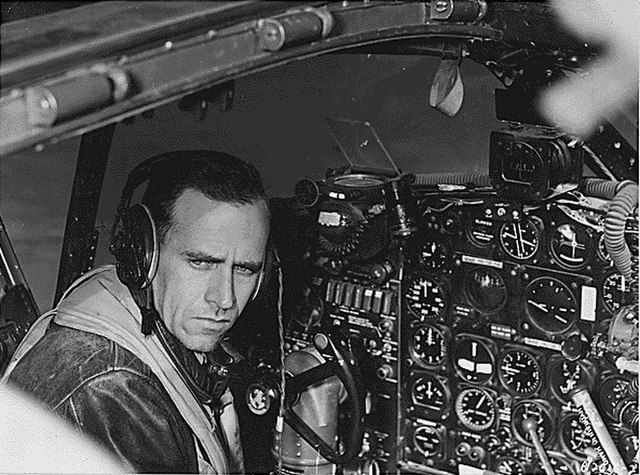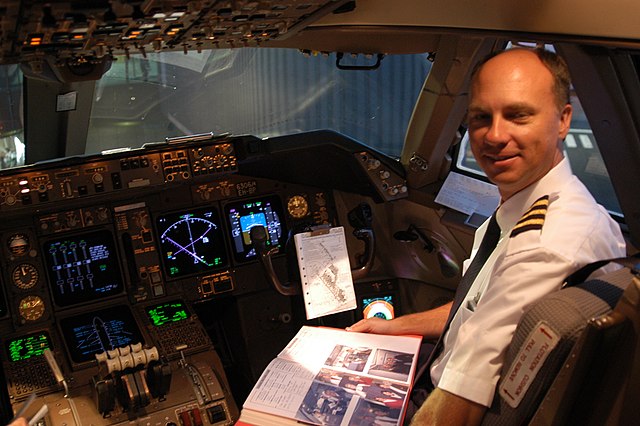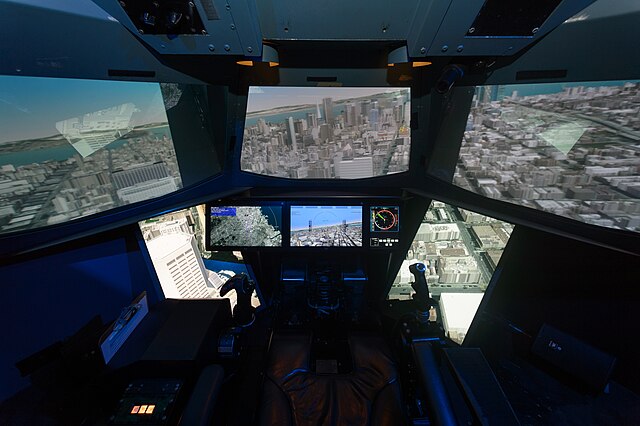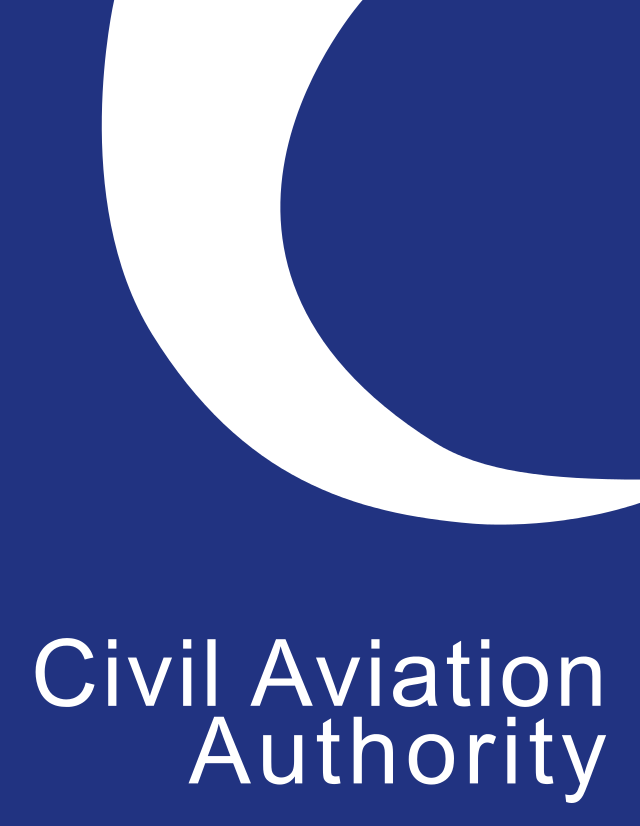In the early days of aviation, there were typically five flight crew members in the cockpit, including the captain, first officer, flight engineer, navigator, and radio operator. However, with technological advancements, the crew complement has been reduced to two: the captain and the first officer. These two-pilot operations have become the norm for passenger air transport. If that’s the case, how is single-pilot operations possible?
Single-pilot operations (SPO) are like the aviation equivalent of a solo performance. The concept of Single-Pilot Operations (SPO) involves flying a commercial aircraft with only one pilot in the cockpit. This lone pilot is assisted by advanced onboard automation and, in some cases, additional ground operators who provide piloting support services. The goal is to streamline operations while maintaining safety and efficiency.
How many crew members have operated an aircraft in the past?
In the early days of aviation, pilots were often the designers themselves, flying relatively simple aircraft with trial-and-error learning. The evolution of pilot training, from the expansion during World War I and World War II to the standardization in the 1920s, is a fascinating journey. The U.S. began regulating aircraft design and pilot training, requiring extensive military flying experience. Most U.S. airline pilots from the 1930s to the 1960s were white men with military backgrounds. Today, diversity has increased, and roughly half of current U.S. airline pilots were never in the military.

The role of flight attendants is about more than just serving meals and drinks. Early airliners were mail planes with minimal passenger space, and passengers had to fend for themselves. Cabin boys were added to assist with luggage and passenger comfort. In 1930, Ellen Church, a registered nurse, proposed that nurses would be ideal flight attendants to care for sick passengers. Boeing hired eight nurses for a trial run, and these “stewardesses” became integral to the airline industry. Over time, nursing degrees were no longer required, but the nurturing, maternal aspect remained key, showing the importance of their role in ensuring passenger comfort.
The Good side of Single Pilot operations.
Let’s delve into the advantages of Single Pilot Operations (SPO) in commercial aviation.
Economic Savings:
SPO can significantly reduce airline operating costs. Airlines save on salaries, training, and other crew-related expenses by having only one pilot in the cockpit. With the rising demand for air travel, cost efficiency becomes crucial. SPO offers a way to maintain profitability while meeting passenger needs.
Coping with Pilot Shortages:
The aviation industry needs more qualified pilots. SPO provides a potential solution by allowing airlines to operate efficiently even with fewer pilots. As experienced pilots retire or leave the industry, SPO can help bridge the gap.
Advancements in Automation and AI:
Modern aircraft are equipped with sophisticated automation systems and artificial intelligence (AI) technology. These systems assist pilots in managing flight parameters, navigation, and communication. With robust automation, a single pilot can effectively handle these tasks.
Reduction in Workload:
In today’s airliner cockpit, there are typically two pilots: the Pilot Flying (PF) and the Pilot Monitoring (PM). SPO concentrates critical flying tasks on one pilot, reducing the risk of errors. The PM can focus on communication, systems monitoring, and managing non-flying procedures. During abnormal conditions, both pilots collaborate to solve complex problems, emphasizing the importance of having two sets of eyes.
Check and Balance:
Having two pilots allows them to cross-check each other’s work. This redundancy minimizes errors that could lead to incidents or accidents. Cross-checks are common in an airliner cockpit, ensuring safety and operational accuracy.
Challenges and Public Perception:
Convincing the general public that SPO is safe remains a significant challenge. Trust in technology and safety protocols must be established. However, SPO may become more feasible and even necessary as technology evolves.
While SPO presents challenges, its potential economic benefits and technological advancements make it an area of interest for the aviation industry.
The Bad Side of Single Pilot Operations.
Let’s explore the challenges and risks associated with Single Pilot Operations (SPO) in commercial aviation.

Reduced Redundancy:
Traditionally, having two pilots in the cockpit provides redundancy. If one pilot becomes incapacitated, the other can take over and safely land the aircraft. In SPO, this redundancy is lost. Relying solely on one pilot increases the risk during emergencies or unexpected situations.
Increased Workload:
A pilot’s role extends beyond flying the aircraft. It includes systems management, communication, and monitoring. In today’s airliners, one pilot is designated as the Pilot Flying (PF), responsible for flying and navigation. The other is the Pilot Monitoring (PM), handling everything else. SPO concentrates critical flying tasks on a single pilot, potentially overwhelming them with workload.
Complex Failures:
During abnormal conditions (e.g., engine failure system malfunctions), both pilots collaborate to solve complex problems. SPO needs this collaboration. Complex failures may be harder to comprehend, requiring active input from both pilots.
Check and Balance:
Having two pilots allows cross-checking of each other’s work. Errors are minimized through this mutual oversight. This safety net is absent in SPO, increasing the risk of serious incidents.
Fatigue and Situational Awareness:
A single pilot faces increased mental and physical fatigue, especially during long flights. Situational awareness can suffer, leading to poor decision-making and potential disasters.
On the other hand, while SPO offers potential benefits, addressing these challenges is crucial to ensuring safety and operational effectiveness.
How do airlines train pilots for SPO?
Training pilots for Single Pilot Operations (SPO) involves specialized programs and adaptations to existing training methodologies. Let’s delve into the details:
Adaptations in Crew Resource Management (CRM):
- CRM focuses on effective communication, decision-making, and teamwork within a cockpit crew.
- For SPO, CRM training is modified to emphasize self-reliance, situational awareness, and efficient workload management.
- Pilots learn to handle tasks traditionally shared with a co-pilot, such as systems monitoring and communication.

SPO training emphasizes non-technical skills like workload management, stress resilience, and decision-making. Pilots learn to recognize fatigue, maintain focus, and manage their mental state during long flights. Understanding human factors becomes crucial when handling all aspects of flight independently.
Airlines provide type-specific training for aircraft used in SPO. Pilots learn about automated systems, emergency procedures, and handling abnormal situations. Simulators play a vital role in practicing SPO scenarios, including single-pilot emergencies.
Regulatory Compliance:
- Pilots must meet regulatory requirements for SPO.
- Training includes understanding minimum crew requirements, limitations, and permissible deviations.
- Airlines ensure pilots are well-versed in relevant regulations from aviation authorities.
SPO pilots learn to assess risks associated with flying solo. Decision-making processes include evaluating weather conditions, fuel management, and alternate plans. Simulated scenarios help pilots practice critical choices under pressure. Handling emergencies without a co-pilot requires thorough knowledge of procedures. Pilots train for engine failures, cabin depressurization, and other critical situations. They practice quick and effective responses to ensure passenger safety.
SPO pilots face increased workload and potential fatigue. Training covers strategies to combat fatigue, including rest breaks, nutrition, and sleep management. They learn coping mechanisms, stress reduction techniques, and mindfulness practices.
Airlines provide recurrent training to keep SPO pilots up-to-date. New technologies, regulations, and safety protocols are part of ongoing education. Pilot associations and regulatory bodies collaborate to shape SPO training standards. Feedback from experienced SPO pilots informs training improvements.
How does automation assist single pilots?
Automation plays a crucial role in assisting single pilots during flight. Modern aircraft are equipped with advanced automation systems that handle routine tasks.
Autopilots maintain altitude, heading, and speed, allowing the pilot to focus on critical decision-making. Let’s explore how:
- Flight Management Systems (FMS):
- FMS automates navigation, route planning, and performance calculations.
- Single pilots can input flight parameters into the FMS, guiding the aircraft along the planned route.
- Emergency Procedures:
- Automated emergency descent systems assist during critical situations.
- These systems calculate and execute optimal descent paths swiftly, ensuring passenger safety.
- Redundancy and Safety Nets:
- Automation provides redundancy by monitoring critical systems.
- Alerts and warnings help single pilots detect anomalies promptly.
- Precision and Stability:
- Automated systems maintain precise flight profiles, reducing pilot workload.
- Autoland’s capabilities ensure stable landings even in adverse conditions.
- Virtual Flight Assistants:
- Emerging technologies introduce virtual flight assistants.

The ugly truth behind single pilot operations
Implementing Single Pilot Operations (SPO) in commercial air transport presents several challenges:
Redundancy: Traditionally, two pilots in the cockpit provide redundancy. If one pilot becomes incapacitated, the other can take over and safely land the aircraft. Removing one pilot increases this risk.
Workload Reduction: In today’s airliner cockpit, one pilot flies (Pilot Flying, or PF) while the other handles communication, systems management, and monitoring (Pilot Monitoring, or PM). This division of roles minimizes errors. During abnormal conditions, both pilots actively contribute to problem-solving.
Check and Balance: Having two pilots allows them to cross-check each other’s work, reducing the likelihood of serious incidents due to human error.
Legal and Regulatory Complexities: For Single Point of Entry (SPOE) strategies in financial stability, overcoming legal and regulatory challenges is crucial.
Market Perceptions: SPO may be perceived as a moral hazard, affecting market confidence.
Cross-Border Coordination: Implementing SPO requires coordination across borders and international regulations.
While SPO offers potential benefits, addressing these challenges is essential for successful implementation.
Are there any regulations specific to SPO?
Specialized operations (SPO) in aviation are governed by regulations that address specific activities beyond commercial air transport.
UK Regulation (EU) No 965/2012 Part-SPO:
- Applies to any aircraft operation (except commercial air transport) involving specialized activities such as agriculture, construction, photography, surveying, observation, patrol, and aerial advertisement.
- Operators engaged in commercial or non-commercial specialized operations using complex motor-powered aircraft must submit a declaration to the Civil Aviation Authority (CAA).
- High-risk commercial specialized operations require additional authorization from the CAA.

EASA (European Union Aviation Safety Agency):
- Specialized operations fall under Commission Regulation (EU) No 965/2012 on air operations.
- Part-SPO complements this regulation and covers various specialized activities.
How do pilots handle emergencies in SPO?
Pilots follow established procedures during specialized operations (SPO) emergencies to ensure safety. They evaluate the nature and severity of the emergency and consider factors like altitude, airspeed, and aircraft configuration. Here are some key steps:
- Aviate, Navigate, Communicate:
- Aviate: Maintain control of the aircraft.
- Navigate: Determine the best course of action.
- Communicate: Inform air traffic control (ATC) and relevant authorities.
- Emergency Checklist:
- Pilots refer to the aircraft’s emergency checklist.
- They follow step-by-step procedures for specific emergencies (e.g., engine failure, fire, loss of pressurization).
- Declare an Emergency:
- If necessary, pilots declare an emergency to ATC.
- This prioritizes their situation and ensures timely assistance.
- Land Safely:
- Pilots aim for the nearest suitable airport.
- They consider factors like runway length, weather, and available services.
Each emergency is unique, and pilots adapt based on the specific circumstances. Safety remains the top priority.
Brief view of safety concerns with SPO.
Safety concerns related to Single-Pilot Operations (SPO) include:
- Task Load: When a single pilot handles all tasks, the workload can become overwhelming, leading to concurrent tasks and potential errors1.
- Distraction: Unexpected events may divert the pilot’s attention, affecting decision-making and response time.
- Lack of Redundancy: With only one pilot, there’s no backup in case of incapacitation or emergencies.
- Controller Concerns: In air traffic control (ATC), single-person staffing can lead to high task loads, distractions, and a lack of redundancy.

Some notable solo flights in aviation history.
Here are some famous solo flights in aviation history.
Charles Lindbergh’s Transatlantic Flight (1927): Charles Lindbergh piloted the Spirit of St. Louis from New York to Paris in 33 and a half hours, completing the first nonstop solo transatlantic flight.

Steve Fossett’s Global Circumnavigation (2005): Apart from being the first solo balloonist to circumnavigate the world, Steve Fossett completed the first nonstop solo flight around the world.

Bert Hinkler’s England to Australia Flight (1928): Australian aviation pioneer Bert Hinkler flew solo from England to Australia, demonstrating remarkable courage and skill.

These pilots exemplify determination, innovation, and the spirit of exploration in aviation.
